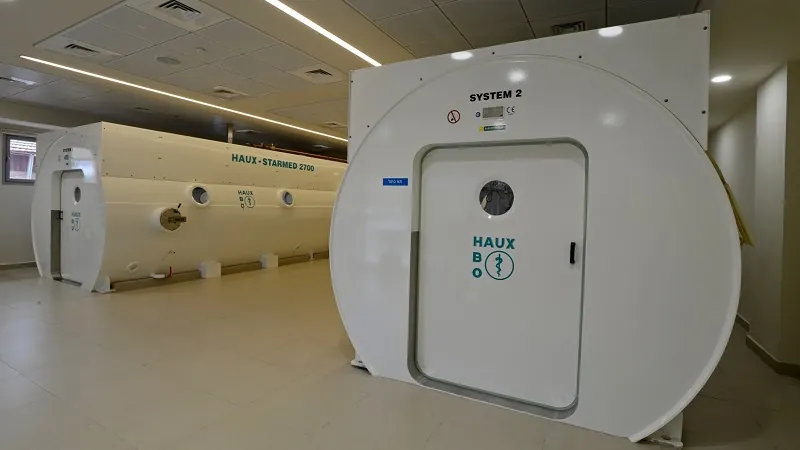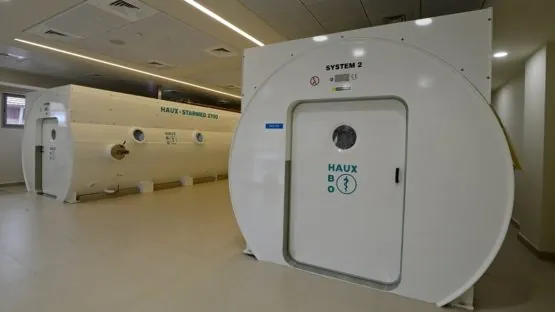A group of Israeli scientists led by Prof. Shai Efrati investigated the effects of hyperbaric oxygen therapy (HBOT) on age-related cognitive decline in healthy older adults, and the results were promising.
The brain is the most metabolically active organ in the body, but it has only limited intracellular energy storage [1]. In absence of local fuel reserves, to sustain neuronal metabolism, the brain depends mostly on cerebral blood flow (CBF), which is why CBF is constantly redirected to the currently active brain regions. CBF accounts for as much as 15% of cardiac output and 20% of resting total oxygen consumption, even though the brain itself comprises just 2% of body mass. CBF dysfunction has been firmly linked to age-related cognitive decline [2].
What is HBOT?
In HBOT, the patient breathes pure oxygen while being subjected to high air pressure, greater than that found naturally on Earth, in a pressure chamber. This results in more oxygen being delivered to the tissues, which promotes wound healing, infection mitigation, and angiogenesis, the creation of new blood vessels.
HBOT is a well-established treatment for a handful of conditions. The list of FDA-approved conditions for HBOT includes necrotizing infections, decompression sickness, non-healing diabetes-related wounds, and even radiation burns. It is also popular among patients with TBI (traumatic brain injury) for its supposed ability to ameliorate various lingering effects of that condition, such as dizziness and cognitive problems. As with many unconventional treatments, HBOT clinics often peddle their product as effective against a plethora of other conditions, including cancer. Prof. Efrati says HBOT has not been proven to prevent or treat cancer.
Prof. Efrati is well-known in Israel and abroad as a pioneer of HBOT. In his clinic, based in Shamir Medical Center, he uses upgraded protocols that add to the basic process, such as repeated fluctuations in oxygen levels, as patients take their masks on and off during the session to alter oxygen consumption. According to him, this technique boosts HBOT efficacy by utilizing what is known as the hyperoxic-hypoxic paradox:
It is now understood that the combined action of intermittent shifts in oxygen concentration induces many of the cellular mechanisms needed for regeneration – the same mechanisms hypoxia triggers but without the hazardous consequences of actual hypoxia.
In particular, this protocol upregulates hypoxic induced factor (HIF). HIF variants HIF-1α and HIF-2α induce the release of vascular endothelial growth factor (VEGF), which promotes angiogenesis and stem cell proliferation. Simply put, when the human body senses a lack of oxygen, it tries to compensate by creating new blood vessels in order to more efficiently distribute the dwindling precious resource.
HBOT and age-related cognitive decline
Rigorous research of HBOT has been appearing more frequently in recent years, yielding evidence that HBOT can improve cognitive functions in post-stroke, TBI and anoxic brain patients even years after the actual incident [3]. However, the current study [4] was the first to examine the effects of the therapy on “normal” age-related cognitive decline.
The researchers enlisted several dozen healthy elderly adults and divided them equally into a study group and a control group. The measurements were taken after 12 weeks of HBOT, during which the participants took 60 sessions or “dives”, as HBOT enthusiasts call them. The most striking, statistically highly significant improvements reported in the study involved attention and information processing speed. The authors also reported a significant increase in the HBOT group’s energy levels compared to the control. Several other improvements, such as in visual memory, were found notable but not statistically significant. The authors hypothesize that further research with larger sample sizes could elucidate the magnitude of these additional effects.
Changes in CBF as a result of the treatment were also measured. Minor changes in the overall CBF were detected, but there were localized significant alterations as well: CBF increased in some regions associated with various aspects of cognitive function. Using statistical methods, the authors found a moderate correlation between the changes in CBF and the cognitive function improvement in particular patients. This finding is consistent with previous research that showed age-related functional decline to be related to reduced perfusion in specific cortical regions rather than to a global reduction in CBF.
One of the problems with HBOT research is setting up a proper control group. Prof. Efrati concedes that it is virtually impossible to meet a double-blind standard, since the treatment produces a clear sensory input (pressure fluctuations). The researchers could be potentially blinded to the groups, but the patients themselves could not be.
Whether and when HBOT will be approved as a therapy for age-related diseases remains to be seen. Meanwhile, home-owned soft chambers have been gaining popularity, but Prof. Efrati strongly warns against them:
The treatment protocol used in our studies cannot be followed with a soft chamber. There is no adequate quality control of the air that flows in, and privately owned chambers bear a high risk of contamination and fire. In short, they are both rather ineffective and unsafe.
Asked about his main takeaway from the study, Prof. Efrati strikes an upbeat note:
It means that so-called ‘normal aging’ should not be taken as a given. With appropriate treatment, age-related functional decline can be reversed.
Conclusion
This research is currently the most vigorous attempt to determine the efficacy of HBOT in treating age-related cognitive decline. It is especially important in the context of longevity research, since such decline is sometimes considered normal rather than a condition that should be studied and confronted. The research also adds to our understanding of the importance of CBF in cognitive function.
Literature
[1] Tarumi, T., & Zhang, R. (2018). Cerebral blood flow in normal aging adults: cardiovascular determinants, clinical implications, and aerobic fitness. Journal of neurochemistry, 144(5), 595-608.
[2] Chen, J. J., Rosas, H. D., & Salat, D. H. (2011). Age-associated reductions in cerebral blood flow are independent from regional atrophy. Neuroimage, 55(2), 468-478.
[3] Boussi-Gross, R., Golan, H., Volkov, O., Bechor, Y., Hoofien, D., Schnaider Beeri, M., … & Efrati, S. (2015). Improvement of memory impairments in poststroke patients by hyperbaric oxygen therapy. Neuropsychology, 29(4), 610.
[4] Amir, H., Malka, D. K., Gil, S., Rahav, B. G., Merav, C., Kobi, D., … & Erez, L. (2020). Cognitive Enhancement of Healthy Older Adults Using Hyperbaric Oxygen: A Randomized Controlled Trial. Aging, 12(13).




